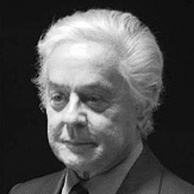
Argomenti affini:
link esterni:
Roberto Capucci
fashion designer (1930)
Roberto Capucci is an Italian fashion designer born in Rome in 1930.
He studied at the Liceo Artistico and the Academy of Fine Arts [with Mazzacurati, Avenali and de Libero.
In 1950 he inaugurated his first atelier in Rome, in via Sistina and the following year he presented his creations for the first time in Florence, at the residence of the Marquis Giovanni Battista Giorgini, entrepreneur and "inventor" of Italian fashion.
In 1952, with other designers, he took part in the first fashion show at the Sala Bianca in Pitti Palace in Florence. A young Oriana Fallaci tells the story, dedicating an article to him in the weekly Epoca for which she is a correspondent.
At just 26 years old, Capucci established himself as an Italian fashion designer, appreciated by Christian Dior, who in an interview with Vogue defined him as "the best creator of Italian fashion" for the originality of his creations.
In 1958 he created the Box Line, an authentic revolution from a technical and stylistic point of view. For this innovative proposal, on September 17, 1958 he received the Fashion Oscar - Filene's Young Talent Design Award - as best fashion creator together with Pierre Cardin and James Galanos,
In 1961 he was enthusiastically welcomed by French critics for the Parisian fashion shows in the calendar of the "Chambre Syndacale de la Mode" which in 1962 led him to open his own atelier in Paris in Rue Cambon.
He receives positive criticism from the press and the honor of being the first Italian designer to be asked to "sign" a product.
1968 was the year he returned to Italy, to Rome, to the atelier in Via Gregoriana, where he presented his collections in the fashion calendar organized by the "National Chamber of Italian Fashion".
In the same year he worked for the cinema, designing the costumes for Silvana Mangano and Terence Stamp for the film Teorema by Pier Paolo Pasolini.
In 1970 he presented his work in the nymphaeum of the National Etruscan Museum of Villa Giulia in Rome, with a collection that revolutionized the tradition of fashion shows, with models wearing low-heeled boots, without make-up and with natural hair. Capucci's great experimentation began in these years, with the inclusion of rigid and structural decorative elements, rich and poor materials, fine fabrics, stones and straw in the collections.
In 1980 Capucci resigned from the National Chamber of Italian Fashion and decided to present his collections as personal artist collections, creating them without following deadlines or calendars.
In 1986 the Verona Arena called him to design the costumes for the "priestesses" of Norma, in homage to Maria Callas.
In 1990 he organized the exhibition Roberto Capucci Art in Fashion - Volume, Color and Method at Palazzo Strozzi in Florence. Greeted with great critical and public praise in museums around the world, including the Kunsthistorisches Museum (Vienna), the Nordiska Museet (Stockholm), the Pushkin Museum of Fine Arts (Moscow), the Philadelphia Museum of Art and the Palace of Venaria Reale (Turin).
In 1995 he presented his creations at the International Exhibition of Visual Arts at the Venice Biennale, in the edition of the Centenary of the Biennale (1895-1995) with 12 "Fabric Architectures" inspired by semi-precious stones created for the occasion.
In 1996 Enel organized the gigantic exhibition of his works at Palazzo Farnese in Parma with the title "In defense of beauty".
In 2005, with the Civita Association, he created the Roberto Capucci Foundation with the aim of preserving his archive which consists of 439 historical dresses, 500 signed illustrations, 22,000 original drawings, a complete press review and a vast photo library and media library.
In 2007 the Museum of the Roberto Capucci Foundation opened in Villa Bardini in Florence, within which exhibitions and intense educational activity were organised.
In April 2012, in collaboration with the Moda e Modi Association of Milan, the "Roberto Capucci" competition for young designers was launched. In addition to clothes, the young designers' homage concerns objects and furnishings. concludes in April 2013 with the award ceremony of the 3 winners at Palazzo Reale in Milan and with the exhibition event at Palazzo Morando.
In his career Capucci has dressed true female icons such as Marylin Monroe, Jacqueline Kennedy, or Rita Levi Montalcini, who in 1986 wore one of her dresses to receive the Nobel Prize for Medicine.






